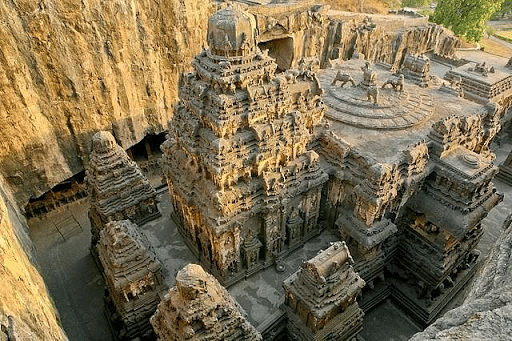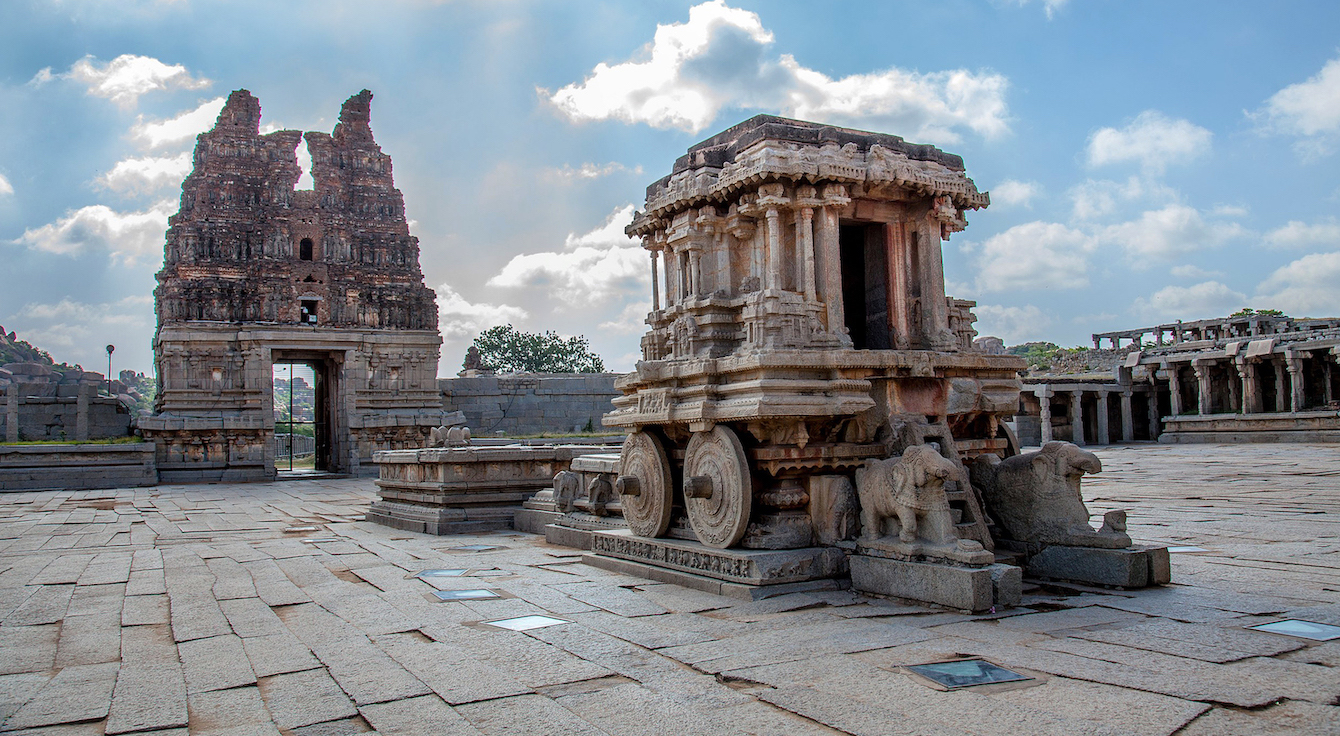South Indian Temple Architecture
From the seventh through the eighteenth centuries, Hindu temples in contemporary Tamil Nadu were built exclusively in South Indian temple style, also known as Dravida Style, which is distinguished by its pyramidal, or kina-type, tower. States like Karnataka (formerly Mysore) and Andhra Pradesh have different varieties.
Buy Prime Test Series for all Banking, SSC, Insurance & other exams
Origin of South Indian Temple Architecture
The basic structure of a South Indian temple is a square-chambered sanctuary surrounded by a peristyle of cells within a rectangular court, with a superstructure, tower, or spire atop it. An associated pillared portico or hall (mandapa) is also present. The temples’ outside walls are divided by pilasters and have niches that house sculpture. The superstructure or tower above the sanctuary is of the kina type and has a pyramidal arrangement of stories that gradually recede from the top.
A parapet of tiny shrines, square at the corners and rectangle with barrel-vault roofs in the middle, separates each story. A cupola with a dome form, a crowning pot, and a finial sits atop the tower.
History of South Indian Temple Architecture
The South Indian style is most fully realized in the splendid Brihadisvara temple at Thanjavur, built about 1003–10 by Rajaraja the Great, and the great temple at Gangaikondacholapuram, built about 1025 by his son Rajendra Chola. Subsequently, the style became increasingly elaborate—the complex of temple buildings enclosed by the court became larger, and a number of successive enclosures, each with its own gateway (gopura), were added. By the Vijayanagar period (1336–1565) the gopuras had increased in size so that they dominated the much smaller temples inside the enclosures.
The Gupta era is where the Dravida style first appeared. The Shore Temple (about 700) and the rock-cut shrines from the 7th century at Mahabalipuram are the earliest surviving examples of the evolved form.
South Indian Temple Architecture: Composition and structure
The three components below, which can be placed in many ways but are almost always found in Chola-style temples, differ solely in terms of the era in which they were built.
- The Mandapas, often known as porches, usually cover and come before the cell door.
- The main components of the quadrangular enclosures that encircle the more famous temples are gate-pyramids, or Gopuras. In
- Dravidian temples, gopuras are quite prevalent.
- These temples are always accompanied by pillared halls (also known as Chaultris or Chawadis), which serve a variety of functions.
In addition to these, a South Indian temple typically features a tank called the Kalyani or Pushkarni, which is utilised for sacred reasons or the priests’ convenience, as well as adjacent housing for all levels of the priesthood and other state- or convenience-related buildings.
South Indian Temple Architecture during Pallavas
The solitary rock temples in Mahabalipuram and their capital Kanchipuram, presently found in Tamil Nadu, are the Pallavas’ most notable architectural achievements. The Pallavas ruled from 275 CE to 900 CE.
- Rock-cut temples from 610 to 690 CE and structural temples from 690 to 900 CE are the oldest instances of Pallava buildings.
- The Shore Temple is just one of the magnificent examples of Pallava architecture found in the rock-cut Group of Monuments at Mahabalipuram, a UNESCO World Heritage Site.
- Both monolithic shrines, where the natural rock has been completely removed and carved to provide an external roof, and excavated pillared halls with no external roof other than the natural rock are included in this category.
- Most of the early temples were devoted to Shiva. A beautiful example of a temple built in the Pallava style is the Kailasanatha temple, also known as Rajasimha Pallaveswaram in Kanchipuram, which was constructed by Narasimhavarman II, also known as Rajasimha.

South Indian Temple Architecture during Chalukyas of Badami
- The Vesara style known as Badami Chalukya Architecture was created during the 543–753 CE period by the Badami Chalukyas, also known as the Early Chalukyas, who governed from Badami, Karnataka.
- The best specimens of their work may be found in northern Karnataka at Pattadakal, Aihole, and Badami.
- The Malaprabha basin still contains more than 150 temples.
The architecture and artwork the Chalukya kingdom left behind are its most enduring legacies. In the Malaprabha basin in Karnataka, there are still more than 150 monuments that are assigned to the Badami Chalukya and that were constructed between 450 and 700.

South Indian Temple Architecture during Rashtrakutas
Some of the best Dravidian temples were created in Ellora (the Kailasanatha temple) by the Rashtrakutas, who governed the Deccan from Manyakheta, Karnataka, between 753 and 973 CE. Their rock-cut architecture style incorporated elements from both north and south India. The Jaina Narayana Temple at Pattadakal and the Navalinga Temples in Kuknur in Karnataka are two other beautiful structures.
- The magnificent rock-cut shrines at Ellora and Elephanta, which are located in modern-day Maharashtra, are examples of the Rashtrakuta contributions to art and architecture.
- They are reported to have built 34 rock-cut shrines in total, but the Kailasanatha temple in Ellora is the largest and most lavish of them all. The temple is an exquisite work of Dravidian art.
- The temple’s ceilings are painted, and its walls are adorned with magnificent sculptures of Hindu mythological figures including Ravana, Shiva, and Parvathi.

South Indian Temple Architecture during Western Chalukyas of Kalyani
- From 973 to 1180 CE, the Western Chalukyas, also known as the Kalyani Chalukyas or Later Chalukyas, controlled the Deccan from their capital Kalyani in present-day Karnataka.
- They furthered the Chalukyan architectural style, known as Western Chalukya architecture.
- The Krishna River-Tungabhadra doab in central Karnataka is home to more than 50 temples.
- The best examples created by the Later Chalukya architects are the Kasi Vishveshvara at Lakkundi, Mallikarjuna at Kuruvatii, Kalleshwara temple at Bagali, and Mahadeva at Itagi.
South Indian Temple Architecture during Pandya
- Temple in Srivilliputhur Andal According to legend, Periyalvar, the Lord’s father-in-law, used the riches he won during arguments held in the Pandya King Vallabhadeva’s court to construct Rajagopuram.
- A 12-tiered tower construction honouring Vatapatrasayee, the Lord of Srivilliputtur, is the city’s most prominent monument. This temple’s tower is 192 feet (59 metres) tall.
- The Meenakshi Temple at Madurai, which serves as the government of Tamil Nadu’s official symbol, is one of the Pandyas’ other important temples.
South Indian Temple Architecture during Cholas
- Rajaraja Chola I and Rajendra Chola, two of the Chola kings who ruled from 848 CE to 1280 CE, constructed temples like the Brihadeshvara Temple of Thanjavur and the Brihadeshvara Temple of Gangaikonda Cholapuram, the Airavatesvara Temple of Darasuram, and the Sarabeswara (Shiva) Temple, also known as the Kampahareswarar Temple at Thirubh.
- The first three of the aforementioned four temples are listed as UNESCO World Heritage Sites under the category of Great Living Chola Temples.
From the reign of the first Chola ruler Vijayalaya Chola, after whom the unique chain of Vijayalaya Chozhisvaram temples at Narttamalai exists, the Cholas were prolific temple builders. These are the oldest Chola-era examples of Dravidian temples. Aditya I, his son, constructed a number of temples at Kanchi and Kumbakonam.

South Indian Temple Architecture during Hoysalas
From their capital Belur and later Halebidu in Karnataka, the Hoysala monarchs dominated southern India from 1100 to 1343 CE. In Karnataka state, they created a distinctive architectural style known as Hoysala architecture. The Chennakesava Temple in Belur, the Hoysaleswara Temple in Halebidu, and the Kesava Temple in Somanathapura are the three best specimens of their architectural style.
- Rather than their military victories, the Hoysalas’ encouragement of the arts and architecture is what has sparked current interest in them.
- Despite persistent threats from the Pandyas to the south and the Seunas Yadavas to the north, the rapid temple construction throughout the kingdom was successful.
- Their architectural style, which is a Western Chalukya-inspired offshoot, clearly displays Dravidian elements.
- As opposed to the classic Dravida, the Hoysala architecture style is referred to as Karnata Dravida and is regarded as a separate architectural heritage with numerous distinctive elements.
South Indian Temple Architecture during Vijayanagara
The Vijayanagara Empire, which governed all of South India from 1343 to 1565 CE, constructed a multitude of temples and monuments in their capital city of Vijayanagara in Karnataka in their unique hybrid style. They combined some of the styles created in South India over the course of several centuries.
They also made a distinctive contribution with the elaborate pillared manatapa, balustrades (parapets), and Yali columns (pillar with charging horse). In the Vijayanagara architectural style, King Krishna Deva Raya and others constructed a number of well-known temples throughout South India.
- The architecture of Vijayanagara is a vivid synthesis of earlier architectural idioms, including the Chalukya, Hoysala, Rashtrakuta, Pallava, Pandya, and Chola.
- Long after the empire’s fall, its legacy of sculpture, architecture, and painting had an impact on the growth of the arts.
- The elaborately pillared Kalyanamantapa (nuptial hall), Vasanthamantapa (open pillared halls), and Rayagopura are its stylistic defining features (tower).
- Due to its durability and the fact that the kingdom was constantly under danger of invasion, artisans chose the hard granite that was readily available in the area.
- Nothing beats the immense open-air theatre of monuments at its capital at Vijayanagara, a UNESCO World Heritage Site, even though the empire’s monuments are dispersed throughout the entirety of Southern India.

South Indian Temple Architecture in Kerala
Kerala in the extreme southwest has a very different style of Dravidian architecture. Very big temples are uncommon, and their shapes are often dominated by sloping roofs with projecting eaves that are grouped in multiple tiers. This is an adaptation to the intense monsoon rainfall, similar to Bengal. A stone core typically lies beneath a timber superstructure. Kerala’s architecture dates to the Chera kingdom in the 12th century and has utilised a number of ground patterns, including circular ones. Multi-building complexes were only recently developed.
South Indian Temple Architecture in Sri Lanka
Architectural designs reflect Sri Lankan culture. The bulk of Jaffna’s residents are of Dravidian descent, and the city is near to South India. There are Jaffna kingdom architectural ruins in Nallur, a former royal city.




 Who Is Delcy Rodriguez? Venezuela’s Inte...
Who Is Delcy Rodriguez? Venezuela’s Inte...
 US Move on Venezuela's Oil: What It Mean...
US Move on Venezuela's Oil: What It Mean...
 US Military Action in Venezuela: Why Was...
US Military Action in Venezuela: Why Was...







